
Manure from a Missouri hog operation set up by the Brinker brothers – Kenny, Dale and Ronnie – has been an integral part of bringing back soil that had been depleted of nutrients and severely eroded.
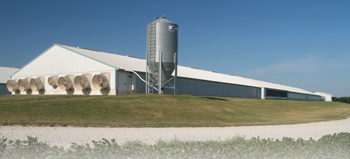
|
| Besides growing crops, the Brinker brothers operate a 650 sow farrow-to-finish operation of Harrison Creek Farm and use the manure effluent to rejuvenate their cropland. |
Manure from a Missouri hog
operation set up by the Brinker brothers – Kenny, Dale and Ronnie – has
been an integral part of bringing back soil that had been depleted of
nutrients and severely eroded.
When it comes to environmental stewardship, and nutrient management, the Brinker brothers of Missouri were instrumental in literally bringing a farm back from the brink.
In 1993, the three brothers – Kenny, Dale and Ronnie Brinker – set up a hog operation, Harrison Creek Farm, near Auxvasse, Missouri, about two hours west of St. Louis. The land the hog operation was located on, however, was depleted of nutrients and severely eroded.
It has been a long, steady climb back since then, but good soil conservation practices and a comprehensive nutrient management plan have taken what was barren soil to high levels of productivity. And an integral part of bringing some of the acreage back involved the use of manure effluent from the swine operation.
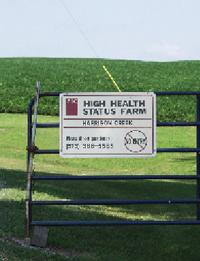 The Brinker Brothers operate their hog operation in conjunction with PIC, who The Brinker Brothers operate their hog operation in conjunction with PIC, who had contacted them about setting up a multiplier farm. Each of the brothers has an interest in the hog operation and also has their own separate acreages and crop operations. |
The Brinker brothers had successful farm operations about 60 miles southeast of Auxvasse, before deciding to make the move slightly north. “We had two older 300 sow farrow to finish farms down there,” explains Kenny Brinker. “But we could see that urban encroachment was going to swallow us up.”
Kenny’s 180 acre farm (Ronnie and Dale also had acreages) was bordered on one side by an industrial park, and what used to be a dairy farm on another side had been developed into high end homes. “There were million dollar-plus homes going in about a quarter mile from where we were,” explains Kenny.
They gradually made the move to Auxvasse. They set up a 650 sow farrow to finish operation at the new location, in conjunction with PIC, who had contacted them about setting up a multiplier farm. The Brinkers eventually wrapped things up with the other farms, with Kenny selling the home farm to the town of Washington, Missouri, which used the land to expand its industrial park. Dale and Ronnie also sold their farms.
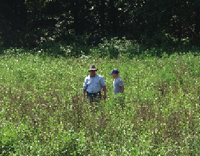 Harrison Creek Farm of Missouri is dedicated to following sound conservation practices. Some 36 different waterways have been installed on some of the farm’s 4400 total acreage through Missouri’s Continuous Conservation Reserve Program and federal Environmental Quality Incentives Program. Six miles of terraces have been built, draining water into the waterways, helping to prevent erosion. Harrison Creek Farm of Missouri is dedicated to following sound conservation practices. Some 36 different waterways have been installed on some of the farm’s 4400 total acreage through Missouri’s Continuous Conservation Reserve Program and federal Environmental Quality Incentives Program. Six miles of terraces have been built, draining water into the waterways, helping to prevent erosion. |
The brothers each still have their own separate acreages and crop operations, but all three have an interest in the hog operation, Harrison Creek Farm. The hog operation itself is located on Kenny and Susan Brinker’s farm.
“We structured it so that everyone has a viable financial interest in the hog operation – it keeps us all dedicated and aggressive towards having the hog operation work well,” says Kenny.
In Missouri, where the average size of farms over the years has become smaller, Kenny and Susan felt fortunate to find a big piece of land: the 1635 acre Mid-State Farm. It was an investment property, and had been owned by two sets of brothers, who lived out of state, for about 30 years.
“For most of that time, they leased it out through a farm management service, and part of the time it was just rented out to local farmers,” says Kenny. “But it was just run on a year-to-year basis. Everyone was farming it as if they might not have it the following year.
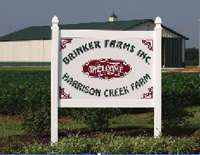 Harrison Creek Farm had the assistance of University of Missouri nutrient specialists in determining the best site for the operation’s hog barns and the lagoon. Harrison Creek Farm had the assistance of University of Missouri nutrient specialists in determining the best site for the operation’s hog barns and the lagoon.
Harrison Creek an award winner The Brinker brothers were recognized this past fall Harrison Creek and three other farms from around the country were selected to receive the award for emonstrating their commitment to protecting the environment while The environmental stewards are selected by judges drawn from pork producers, academia and environmental organizations. The judges look for pork producers from throughout the country who are representative of the pork industry’s commitment to minimizing its footprint on the environment. Farms are evaluated on their manure management systems; water and soil conservation practices; odor-control strategies; farm aesthetics and neighbor relations; wildlife habitat promotion; innovative ideas used to protect the environment and an essay on the meaning of envir onmental stewardship. “These producers go to great lengths to farm responsibly, protecting the resources and their environment, nurturing relationships with their neighbors and their community Kenny Brinker, who owns Harrison Creek Farm with brothers Dale and Ronnie, said it is important that the public knows the hog industry is doing a responsible job, especially in the area of manure management. “We’re using it in an environmentally safe way to promote and grow more crops for our livestock.” |
“We felt fortunate in finding such a large acreage, but the ironic thing is that we later found out the land had been on the market for three years. A neighbor told us later that the general feeling locally was that the acreage had been farmed out. Crops in recent years were looking so bad that people thought the land was of little use, that it would be too expensive – or plain not possible – to bring it back to productivity.”
After the purchase, they took some soil tests. Local agronomists said they had never seen P and K levels register so low: it was clear not much had been done to build up the soil or preserve it over the years.
They went into action, using a good deal of commercial fertilizer to bring the soil back. But they have also used two Reinke center pivot irrigation systems – that distribute manure effluent and cover some 200 acres – which have been instrumental in bringing that soil back.
“Using the hog manure has been very helpful,” says Kenny.
They are at the point now that they apply a little nitrogen, but never have to apply any phosphorus or potassium. “In addition to helping to bring the soil back, we estimate we’re now saving up to $12,000 a year over commercial fertilizer because we’re using the lagoon effluent.”
All of their hog barns are slatted, and sit over shallow pits from 18 to 24 inches deep. They have a pull-plug recharge system, with the manure flushed to a seven acre aerobic lagoon. It has 18 months capacity. Recycled liquid is pumped back into the empty pits to reduce odor inside the barns.
The lagoon is 15 feet deep, though Kenny notes they only pump down about 6.5 feet. Effluent is pumped through underground eight-inch lines to the center pivots.
Generally, the effluent is pumped out and applied over the 200 acres in July and August. This past year, however, they irrigated the fields right after planting
the corn, due to it being dry, to make sure they had enough moisture for a uniform crop.
“We try to avoid application during the period of corn pollination. Seems like if you have a hot day and you’re putting lagoon water on the crop when it is pollinating – particularly lagoon water because it has a certain amount of
nitrate in it compared to well water – it seems to burn the blossoms a bit on
the tassels.
“We try to apply most of the effluent prior to tasseling and right after pollination occurs to get the best bang for our buck, both nutrient-wise and moisture-wise.” The amount of effluent applied varies a bit – but in an average year, about 1.75 inches will be applied over the 200 acres.
“That amount is not going to give you a bumper crop in and of itself, but it does a good job of adding P and K into the ground.”
The Reinke system they use has low pressure drops, with PVC outlets that hang down and turn slowly.
“We had never operated a center pivot system before and were told that one of the problems of using a center pivot to spread effluent is that if you are shooting the effluent up in the air, it creates more odor. So rather than go with a system that sprays water up, we put in one of the low pressure systems that has drops that come down to about four or five feet off the ground. The tips at the end of the PVC pipe spread the effluent around, and we think it helps reduce the odor.”
They have a portable 300 horsepower John Deere pump that sits down at the lagoon to move the effluent through the pipe and to the pivots. Following state regulations, the system is checked hourly to make sure everything is working properly. “The pump has kill switches to shut it down, so if a wheel got stuck or a line broke, the pressure would change and it would shut down automatically, with no extra effluent spread.”
In addition, nozzles are checked at the end of each day’s operation to ensure there is no plugging or organic matter build-up.
They started out with one pivot on 120 acres, and added a second pivot two years ago to apply effluent on an additional 80 acres. Effluent samples are taken and tested, and the soil is tested yearly, to determine how much P and K is being added.
“If we started to build P and K values above sustainable levels, which we don’t think is going to happen, we can always go to another part of the farm, put a
pivot up and spread over more acres,” says Kenny.
Following state regulations, the farm keeps track of how many hours the system is in operation, how much effluent is applied (using the flow meter), the nutrient value of the manure effluent and exactly when the applications are done. Lagoon levels are also monitored and recorded. All of this information is filed and included with the annual summary the farm presents to the Missouri DNR.
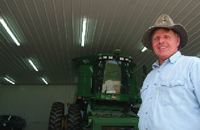 Kenny (above) and Susan Brinker sold the family farm near Washington, Missouri, to set up operation on the 1635 acre Mid-State Farm. Kenny (above) and Susan Brinker sold the family farm near Washington, Missouri, to set up operation on the 1635 acre Mid-State Farm. |
“The DNR have done a good job here,” says Kenny, noting the annual summary for farms runs to a very brief – but still comprehensive – three double-sided pages. “In general, we’ve had a good relationship between the livestock sector and the DNR in Missouri.”
Harrison Creek Farm has built up a relationship with the University of Missouri, which is basically down the road in Columbia. They had the assistance of nutrient specialists John Lorey and Charlie Fulhage in laying out operations on the farm, and determining the best site for the hog barns and the lagoon.
Over the last two years, these two men have been regular visitors to the farm to take monthly lagoon water samples, part of a study to determine now much nutrient levels change in a lagoon over the course of a year. They are also carrying out studies on the sludge depth of the lagoon and the nutrient content of that sludge. They have grid sampled (32 different grid samplings) and GPS
co-ordinated the sludge in the lagoon.
“It’s been interesting,” reports Kenny. “They’ve found that the sludge will move around seasonally, with the wind currents, on the bottom of the lagoon.”
There is one exit pipe moving manure into the lagoon, at the northwest corner, and the Brinkers thought there would be a build-up of sludge at the southwest corner. “But that wasn’t what they found,” says Kenny. “The deepest sludge they found was a spot we thought would be the shallowest. It also seems that the sludge, over a period of time, circles around the lagoon clock-wise.”
Through their studies and sampling, the university has determined that there is enough P and K in the sludge to supply the farm for about four years. The trick is finding an economically feasible way to remove it. A floating dredge could be used to move it to a drag hose system or it could be moved to tanks that could transport the sludge to outlying fields.
“Right now, the cost of doing that would be, at best, equal to the cost of commercial fertilizer,” Kenny notes.
But in the future, as the cost of commercial fertilizer increases, and perhaps the methods of accessing that sludge become more economical, it could be a very viable way to obtain nutrients. “If the cost of commercial fertilizer got too high, we could basically start mining our own fertilizer out of the lagoon.”
For the time being, the Brinkers are pleased they have been able to turn things around with the farm. “There’s always some fine tuning to be done, but the soil is back to about where we want it to be in terms of the degree of fertility and erosion control measures,” says Kenny.
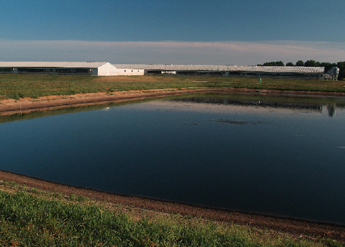 Harrison Creek Farm operates a pull-plug recharge system, with the manure flushed to a 7.0 acre aerobic lagoon with 18 months capacity. The lagoon is 15 feet deep, although it’s only pumped down about 6.5 feet. Harrison Creek Farm operates a pull-plug recharge system, with the manure flushed to a 7.0 acre aerobic lagoon with 18 months capacity. The lagoon is 15 feet deep, although it’s only pumped down about 6.5 feet. |
There have been other significant improvements to the farm. Some 36 different waterways have been installed on their total acreage through Missouri’s Continuous CRP and federal EQIP programs. Six miles of terraces have been built, draining water into the waterways, helping to prevent erosion.
There have been subsequent land purchases since they first set up the farm – the Brinkers now farm 4400 acres, mostly a corn soybean rotation, all no-till. Kenny noted they purchased a nearby farm in the last several years, and they’ve since carried out grid sampling on that acreage and – for the first time – are trying variable rate fertilization.
There may be further land purchases, Kenny added. “A lot of financial advisors would tell you to spread your investment out, buy a little of this and a little of that. But from our perspective, we’ve grown up knowing how to farm and are very comfortable with that.
“If we have the ability and things work out well, we would probably buy other farmland in the area. We take great enjoyment in taking a piece of ground like we had here that was a little neglected and bringing it back into productivity and making it a nice looking place.”